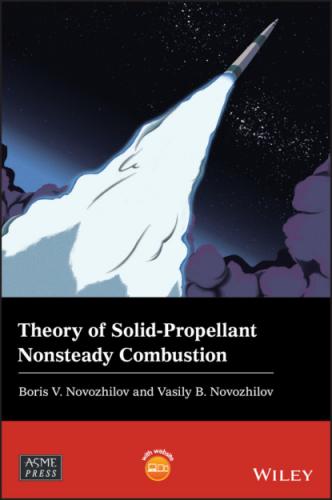14 9 Influence of Gas‐phase Inertia on Nonsteady Combustion 9.1 Introduction 9.2 Steady‐state Combustion Regime Stability 9.3 Burning Rate Response to Harmonically Oscillating Pressure 9.4 Acoustic Admittance of the Propellant Surface 9.5 Combustion and Extinction Under Depressurization 9.6 tr Approximation
15 References
16 Theory of Solid‐Propellant Nonsteady Combustion Problems
17 Theory of Solid‐Propellant Nonsteady Combustion Problem Solutions
18 Index
List of Tables
1 Chapter 1Table 1.1 Properties of the condensed phase.Table 1.2 Properties of combustion products.Table 1.3 Burning rate and surface temperature of the propellant N atT a = 20 ...Table 1.4 Burning rate and surface temperature of the propellant N (Zenin 198...Table 1.5 Burning rate and surface temperature of the propellant N (Zenin 198...Table 1.6 Burning temperatures of the propellant N atT a = 20 °C.Table 1.7 Burning temperatures of the propellant N atp = 20 atm...
2 Chapter 3Table 3.1 Extraction from Laplace–Carson transform tables.Table 3.2 The parameters k , r and the critical values r* for ballistite N ...Table 3.3 Burning rate and surface temperature of ballistite N as a function ...Table 3.4 Parameters of the combustion zones of ballistite N as a function of...Table 3.5 Parameters k , r , r * and other experimental data for ammonium per...
3 Chapter 8Table 8.1 Parameters used in the transient combustion regime simulations and ...Table 8.2 Values of pressure, burning rate, and apparatus constant at final s...
4 Chapter 9Table 9.1 Parameters involved in the solution (9.56) for the complex amplitud...Table 9.2 Comparison of the t c approximation, the t r approximation, and the an...Table 9.3 Comparison of the t r approximation and the analytical solution obtai...
List of Illustrations
1 Chapter 1Figure 1.1 Combustion wave structure of a homogeneous propellant. I, preheat...Figure 1.2 Michelson temperature distribution.Figure 1.3 Dependence of burning rate on surface temperature for ballistite ...Figure 1.4 Sketch of the gas temperature profile during combustion of ballis...Figure 1.5 Erosion coefficient as a function of tangential gas velocity.Figure 1.6 Spatial distribution of the erosion coefficient.
2 Chapter 2Figure 2.1 Procedure for obtaining the dependence of burning rate on surface...Figure 2.2 The dependence of burning rate on surface temperature gradient.Figure 2.3 Transitional regimes in the plane (f, u).Figure 2.4 Burning rate variation under rapid pressure change.Figure 2.5 Burning rate variation under slow pressure change.Figure 2.6 Ratio between approximate temperature profiles and the exact temp...
3 Chapter 3Figure 3.1 Stability boundary of the steady‐state regime under constant pres...Figure 3.2 Burning rate (1) and its asymptotic (2) for r = 0, Figure 3.3 Burning rate (1) and its asymptotic (2) for r = 0, Figure 3.4 Burning rate (1) and its asymptotic (2) for r = 0.25...Figure 3.5 Regions of typical combustion regimes: 1, r*; 2, r − ; 3,...Figure 3.6 Burning rate (1) and its asymptotic (2) for r = 0.5 Figure 3.7 Burning rate (1) and its asymptotic (2) for r = 0.095...Figure 3.8 Burning rate (1), its asymptotic (2), and the terms v 1d (3) and v...Figure 3.9 Burning rate (1), its asymptotic (2), and the terms v 1d (3) and v...Figure 3.10 Stability boundary of the steady‐state combustion regime: a , ana...Figure 3.11 Frequency at the boundary of the steady‐state combustion regime:...Figure 3.12 Stable steady‐state regime: k < k 1 , k = 1.95...Figure 3.13 T regime: k 1 < k < k 2 , k = 2.05...Figure 3.14 2T regime: k 2 < k < k 3 , k = 2.08...Figure 3.15Figure 3.15 4T regime: k3 < k < k4...Figure 3.16 8T regime: k > k 4 , k = 2.0923, and...Figure 3.17 Chaotic combustion regime: k = 2.0952.Figure 3.18 Succession of period doubling and transition to chaos upon incre...Figure 3.19 Burning rate dependence on the surface temperature gradient for ...Figure 3.20 Burning rate of ammonium perchlorate as a function of pressure....
4 Chapter 4Figure 4.1 Linear response function of burning rate. k = 1.5, Figure 4.2 Effect of variation of parameter k on the real part of the burnin...Figure 4.3 Effect of variation of parameter r on the real part of the burnin...Figure 4.4 Effect of variation of parameter δ on the real part of the b...Figure 4.5 Real part of the linear response function of burning rate. k = 1....Figure 4.6 Real parts of linear response functions of burning rate U and G ....Figure 4.7 Quadratic correction to the constant component of burning rate. k...Figure 4.8 Real part of the response function of burning rate for double fre...Figure 4.9 Quadratic response function of burning rate U n,m . k = 1.5...Figure 4.10 Quadratic response function of burning rate Un, − m...Figure 4.11 Constant components of response functions of burning rate and ac...Figure 4.12Figure 4.12 Real parts of response functions of burning rate and ...Figure 4.13Figure 4.13 Real parts of response functions of burning rate and ...Figure 4.14 Real parts of response functions of burning rate and acoustic ad...Figure 4.15 Resonance curves for different amplitudes of the exciting force....Figure 4.16 First type of resonance curves.Figure 4.17 Second type of resonance curves.Figure 4.18 Third type of resonance curves.Figure 4.19 Fourth type of resonance curves.Figure 4.20 T regime. h < h (1) , h = 0.1.Figure 4.21 Time dependence of burning rate. Dashed curve, h = 0.16...Figure 4.22 2T regime. h (1) < h < h (2) , h = ...Figure 4.23Figure 4.23 4T regime. h(2) < h < h(3)...Figure 4.24Figure 4.24 8T regime. h(3) < h < h(4)...Figure 4.25 Chaotic combustion regime. h > h (4) , h = 0.1835...Figure 4.26 Frequency–amplitude diagram.Figure 4.27 Dependence of pressure oscillation amplitude on frequency
